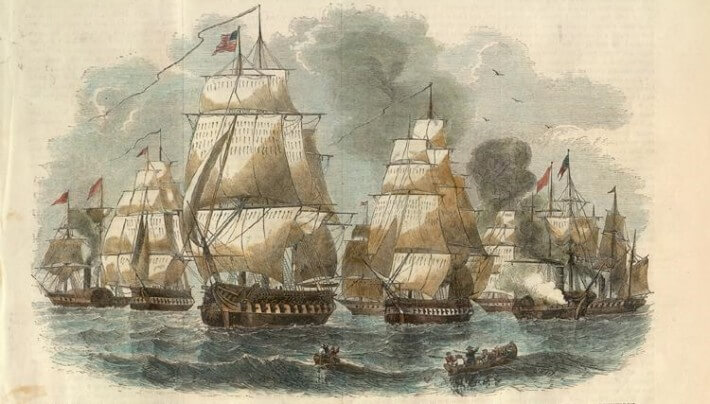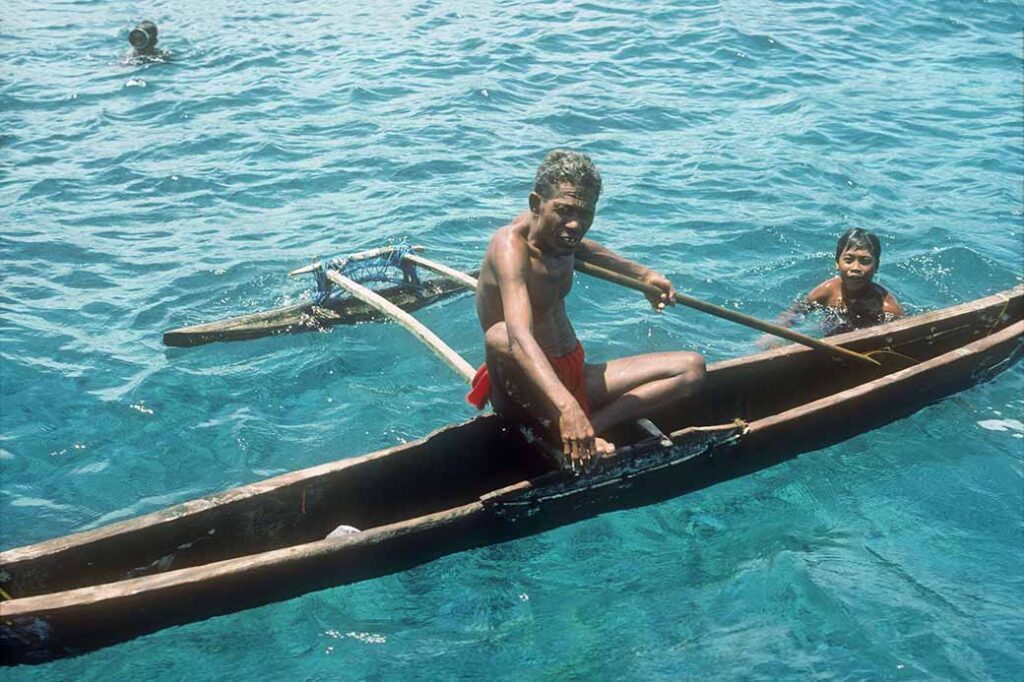
The Pacific Ocean is a vast expanse that serves as a conduit for connecting numerous islands and coastal communities. Contrary to the early European explorers’ perception of it as an empty void, it functioned as a bustling network that facilitated migration, trade, and defence. This article explores the naval skills and traditions of regions such as Melanesia, Micronesia, Polynesia, the Philippines, the Ryukyu Islands, and the Aleutian Islands prior to global conflicts and European colonisation.
The Unangan Mariners of the North Pacific

The Ingenuity of the Kayak. The Unangan people, also known as Aleuts, from the Aleutian Islands, possess a distinctive maritime culture. They did not employ large warships or engage in extensive trading. Instead, they crafted specialised hunting kayaks known as baidarka (iqyax̂) and larger vessels called umiaq. Due to the scarcity of trees, they used driftwood, bones, and sinew to construct lightweight and flexible frames, which were then covered with waterproof sea mammal skins sewn by women using needles made of bones. The baidarka features a forked bow that enhances its speed and stability in the frigid waters of the North Pacific. These boats were crucial for survival, enabling the Unangan to hunt sea otters, seals, walruses, and whales. The Unangan’s proficiency with these vessels demonstrates their adaptation to a challenging marine environment, prioritising survival over military power.

Conflict and the Colonial Encounter. Archaeological evidence suggests instances of violence, but the details of Unangan naval warfare prior to colonisation remain ambiguous. Their maritime technology was oriented towards survival, rendering them susceptible to Russian explorers who arrived in the 18th century.
The arrival of Russian traders marked a tragic period for the Unangan people. Recognising the Unangan’s adeptness at hunting sea otters, the Russians coerced them into participating in the fur trade. They frequently took Unangan women and children hostage to compel men to hunt more effectively. In 1762, the Unangan attempted to resist and succeeded in destroying numerous Russian vessels; however, their efforts were insufficient. This exploitation, coupled with starvation and diseases introduced by Europeans, resulted in an 80% decline in the Unangan population. The advanced maritime technology of the Unangan, developed over millennia, was appropriated by Russian settlers and used against them. This shows how indigenous technological advancements can be co-opted by a more ruthless power, contributing to the creators’ downfall.
The Ryukyuan Maritime Network

The Tributary Kingdom. The naval history of the Ryukyu Kingdom contrasts with that of the Philippines. Although situated between East and Southeast Asia, the Ryukyuans prioritised trade and diplomacy over military conquest. For two centuries, the kingdom served as a pivotal centre in an extensive maritime trade network, known as its “golden age.” This success was based on a unique relationship with Ming and Qing China, which began in 1372 CE. Although this system appeared to be one of submission, it was a shrewd economic arrangement that benefited the Ryukyuans. In exchange for tributes such as sulphur and horses, Ryukyuan envoys received valuable silk textiles and access to the Chinese trade network. China also provided ships to the Ryukyuan fleet and permitted some Ryukyuans to study in Beijing, thereby reinforcing the nexus between trade and diplomacy in the tributary system of the time. The kingdom functioned as an intermediary, facilitating the exchange of Japanese silver and Chinese goods for Southeast Asian spices, tin, and ivory. This emphasis on diplomacy and trade highlighted that the kingdom’s maritime strength was derived from its economic prosperity rather than vice versa.
A Military for Defence. The Ryukyu Kingdom maintained a military primarily for defensive and internal purposes. The army, under the control of the royal family, was responsible for maintaining order and safeguarding tribute ships from piracy in the East China Sea. The kingdom’s strategic focus was not on territorial expansion; rather, its survival and prosperity were dependent upon navigating a complex diplomatic and trade structure between China and Japan, rather than relying on military force.

The limitations of trade-focused naval power were exposed during the 1609 Satsuma invasion, despite the Ryukyuan military’s valiant efforts, they were defeated by a substantial Japanese force equipped with advanced weaponry, such as the arquebus. This encounter was not a conventional naval battle but a confrontation between two distinct strategies: one utilising the sea for commerce and the other for demonstrating power and exacting tribute. This event illustrates how a proficient naval culture can become obsolete when confronted with a power possessing divergent objectives and superior military technology. Consequently, the Ryukyuans were compelled to pay tribute to the Satsuma Clan while remaining tributary to China, highlighting their status as a dependent state between two formidable nations.
The Oceanic Wayfinders- Polynesia and Micronesia

Polynesian and Micronesian peoples are renowned for their navigation expertise. They traversed thousands of kilometres across open oceans without the aid of modern instruments, such as compasses or maps. Their “wayfinding” constitutes a sophisticated science grounded in the observation of natural phenomena. This knowledge was orally transmitted, often through songs, to aid in memorisation. Navigators primarily relied on stars as their guiding tools. They memorised the rising and setting positions of hundreds of stars and used them as compasses. For instance, a navigator journeying from Tahiti to Hawaii would sail until the star Arcturus (Hōkūleʻa in Hawaiian) was directly overhead, indicating the correct latitude, and then proceed to sail east or west of the latitude line. In the absence of visible stars, they employed the sun and patterns of ocean swells and winds. Beyond fundamental techniques, navigators discerned subtle indicators often overlooked by European sailors. They could interpret wave patterns, water colour, and cloud formations to locate land up to 100 miles away from the shore. Watching birds also played a crucial role in this regard. Certain seabirds, such as the white tern and noddy tern, venture out to sea in the morning and return to land at night, signalling the proximity of the islands. Navigators could even differentiate between a young pilot bird and an experienced one to avoid making errors. These meticulous observations and retention of knowledge exemplifies a sophisticated application of science and understanding of the human mind.
The vessels employed for these extensive voyages were outrigger and double-hulled canoes, known by various names, such as waka (Māori and Hawaiian), ndrua (Fijian), and pahi (Tahitian). These boats are characterised by their speed, stability, and capacity to transport numerous individuals and supplies. The Micronesian baurua and proa were particularly admired by European explorers for their distinctive hulls and outriggers, which enabled them to achieve speeds of up to 22 knots, surpassing European ships. These navigation and boat-building skills reflect a clear understanding of the maritime and natural environments.

The history of oceanic travel is not a straightforward narrative of progress. For instance, following the settlement of Tonga and Samoa, there was a “long pause” of approximately 1,000 years before the expansion into Eastern Polynesia. This hiatus implies that long-distance navigation was either lost, deemed unnecessary, or that a cultural transformation was required before further explorations. This type of knowledge is fragile and requires intergenerational transmission to be preserved. Certain Polynesian islands became isolated when these techniques were lost.
Warfare, Prestige, and the War Canoe. Seafaring is closely tied to exploration and survival, but also to frequent intergroup conflicts. In Melanesia, warfare was governed by a “warrior ethic” that valued bravery, violence, and vengeance, manifesting in practices such as raiding, headhunting, and cannibalism, particularly in the Western Solomons and New Caledonia.

The tomako, a crescent-shaped war canoe from the Western Solomon Islands, had played a pivotal role in headhunting raids. These vessels were not merely modes of transport but also served as ritual objects adorned with shell inlays and figureheads (nguzunguzu) for spiritual protection of the crew. Headhunting constituted ritual warfare, a means to acquire the spiritual power of the deceased, with the captured heads displayed in canoe houses as emblems of the community’s strength. This underscores the spiritual and symbolic significance of naval conflict beyond mere territorial or economic considerations.
In certain regions, status and power were contested without any conflict. In the New Guinea Highlands and parts of the island of Melanesia, individuals engaged in large feasts, pig exchanges, and gift-giving as alternatives to warfare. This reflected a complex culture in which rivalry was expressed through both combat and organised economic competition, with an emphasis on maintaining social equilibrium and status rivalry rather than conquest.
The Thalassocracies of the Philippine Archipelago

The Age of the Karakoa. In the pre-colonial Philippines, naval power was of paramount importance, facilitating the emergence of robust maritime nations. The principal warship was the karakoa, a large vessel equipped with an outrigger. Indigenous Filipinos, particularly Kapampangans and Visayans, used it for raiding. Europeans admired the speed and manoeuvrability of the karakoa, they found the low freeboard and outriggers as its weak points.
The design of the Karakoa shows advanced indigenous shipbuilding skills. The Karakoa featured a crescent-shaped hull with a shallow draft, which enabled navigation close to the shore. The hull was assembled using dowels and fibre lashings instead of nails, which conferred a greater flexibility to the structure. This flexibility allowed the vessel to withstand impacts that would compromise the structural integrity of European ships. Its symmetrical design facilitated rapid changes in direction, providing a significant tactical advantage as it could achieve speeds of 12–15 knots, surpassing the Spanish galleons, which could only reach 6 knots. This points to a strategic preference for speed and surprise over cumbersome and slow galleons.
Karakoa were constructed for martial purposes. It was equipped with bronze or brass swivel guns, known as lantakas, and occasionally larger iron cannons crafted by local blacksmiths. A raised bamboo deck, or burulan, was positioned above the rowers to accommodate warriors and passengers, emphasising its dual role as a troop transport and warship.

The Culture of Pangangayaw. Karakoa were employed in traditional sea raids known as pangangayaw or mangayaw. These were not arbitrary acts of piracy but rather significant sociopolitical endeavours akin to Viking expeditions. They were conducted to acquire prestige, plunder, and captives, playing a crucial role in the political and economic lives of maritime societies of the time. Participation in these raids was a fundamental duty for the warrior classes, timawa, and maharlika. Their valor and accomplishments were commemorated on their bodies through extensive tattooing, leading the Spanish to refer to the Visayans as the Pintados, or “the painted ones.” This indicates that proficiency in naval warfare was not merely a military skill but also an integral aspect of personal identity and social status. The power and wealth of the datus (chiefs) were subject to their ability to lead these fleets for trade and raids, making naval strength a foundation of statehood. The emergence of “maritime-oriented harbour principalities” that engaged in trade with various Asian states was facilitated by their naval prowess, with the karakoa serving as both a symbol and instrument of this power.
Conclusion

The study of pre-colonial naval traditions across various island regions reveals that “naval prowess” encompasses a diverse array of cultural and technological adaptations to each society’s unique environmental, economic, and political contexts. The militaristic maritime capabilities of the Philippines starkly contrast with the trade-oriented diplomacy of the Ryukyus. Similarly, the Polynesians’ long-distance migratory voyages differed from the Unangan’s subsistence hunting. Each culture’s maritime engagement offers insights into local engineering and strategic practices.
The advent of colonial powers irrevocably altered these societies, during this era, indigenous knowledge has suffered significant loss. Traditional shipbuilding practices in the Philippines had been suppressed, and navigation traditions in Micronesia have almost vanished. The Unangan population has declined due to these factors. Nevertheless, the skills and knowledge from the past persist.

